This week marks the anniversary of the devastating Nepal earthquake of April 2015. A year after magnitude 7.8 tremors wreaked havoc on over 900 heritage buildings and caused over 8,000 deaths in the Kathmandu Valley, conditions are still difficult. The Indian blockade, which cut off many supplies to the Valley, ended only in March; government bureaucracy has been slow and difficult; materials are scarce and often poor in quality. The needs are enormous, and many monuments in this extraordinary pocket of seven UNESCO world heritage sites may never be rebuilt.

Pre-earthquake panoramic view of Patan Darbar (Royal) Square as seen from the Patan Palace. (The palace west facade is visible at the far ends of the photo). Photo: KVPT
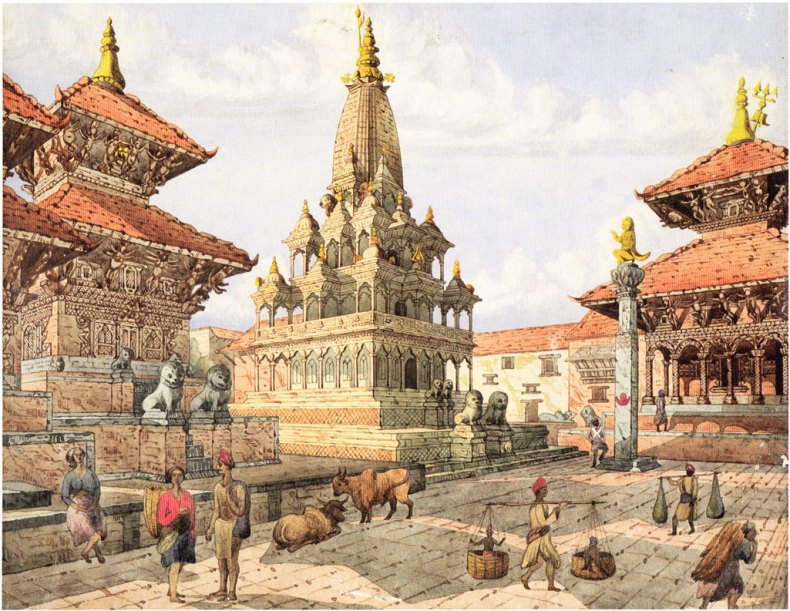
Patan Darbar Square with the Krishna Temple (centre), the Vishveshvara Temple (right) and the Carnarayan Temple (left) (c. 1855), Henry Ambrose Oldfield. British Library
There are signs of progress, though. One local organisation was ready to help immediately after the earthquake. The Kathmandu Valley Preservation Trust, an American and Nepalese charity that has worked since 1991 to preserve and restore the Valley’s extraordinary architectural heritage (and for which we work), responded within days to the damages and collapsed monuments. Efforts focused on the country’s finest urban ensemble and its most visited cultural site, the Patan Palace and Royal Square, but also encompassed other sites in Patan and Kathmandu. Before it was safe to return to their own homes, KVPT’s staff organised local efforts to protect all the loose pieces of the fallen and damaged structures in Patan Darbar from looting and monsoon rains, and then collected them in the palace courtyards. A workshop was created in the palace gardens to house the beautiful wood carvings and other artefacts, and to sort, identify, and repair them in preparation for rebuilding.
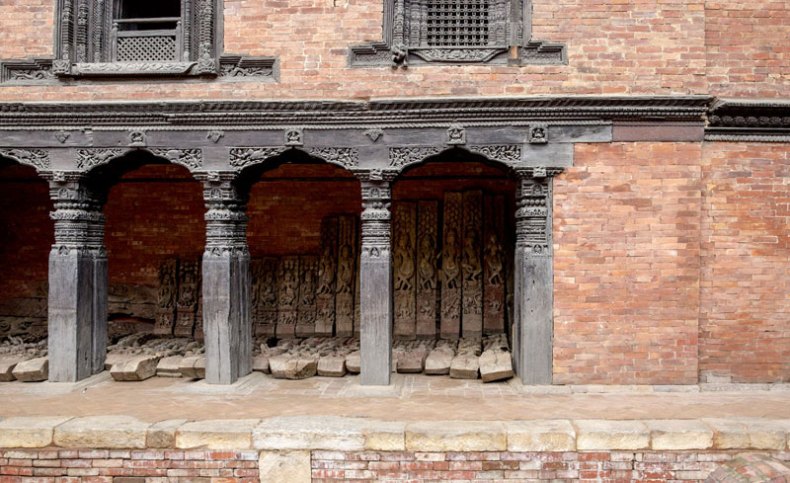
Elaborately carved wooden struts rescued from a temple that collapsed in Patan Darbar Square, stacked in the courtyard of the Keshav Narayan Cok, a palace wing restored in the 1990s by the Austrian government that now houses the Patan Museum. The struts will be incorporated into the rebuilt temple. Photo: Scott Newman
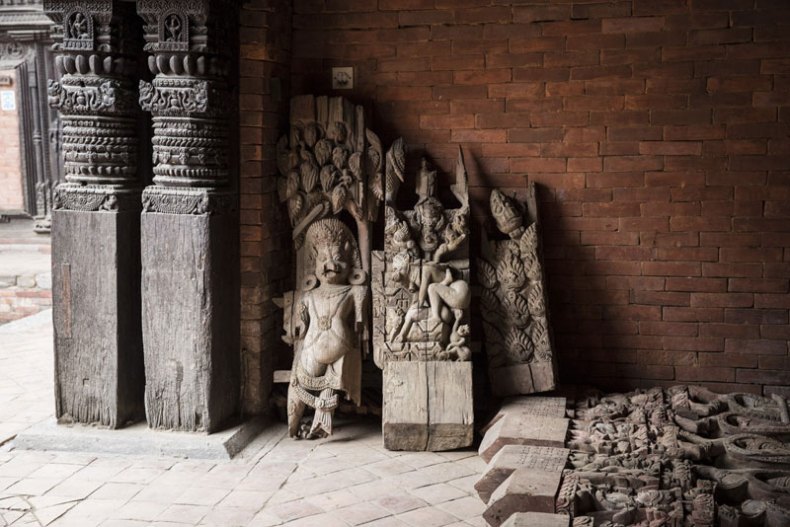
Architectural fragments rescued from the debris of a fallen temple in Patan Darbar Square are sheltered in a palace courtyard, now part of the Patan Museum, awaiting conservation and reuse. May 2015. Photo: Scott Newman
In the subsequent months, a worldwide outpouring of support, including a royal visit by Prince Harry just last month to see the Patan Palace restoration launched by his father, has helped the Trust to begin planning and design for over a dozen damaged temples, palace towers, rest houses and other structures in the royal palace and square. Because KVPT projects include careful structural designs for earthquake resistance, only three of the Trust’s past projects suffered significant earthquake damage. The Trust continues to improve the seismic strength of threatened structures, making the greatest possible use of traditional techniques in combination with unobtrusive new measures to help increase future safety and durability. KVPT brings a quarter-century of experience to these specialised structures, and is the only organisation to work closely and regularly with the Nepal government on such projects.
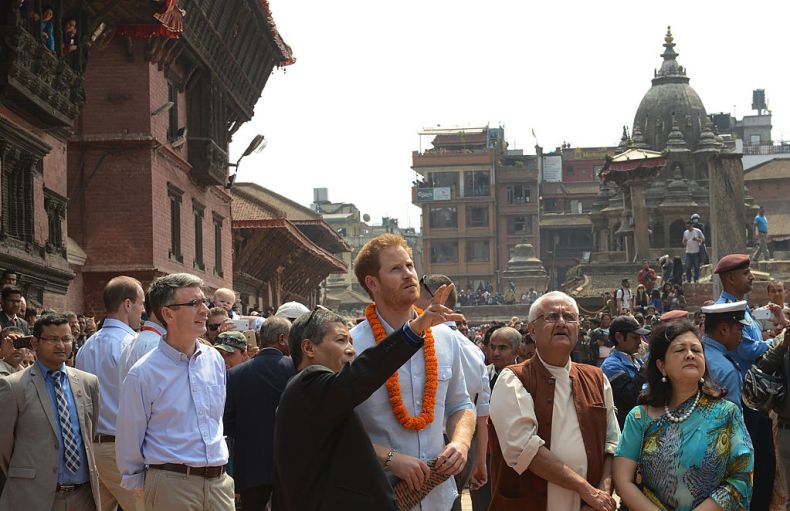
Britain’s Prince Harry speaks with officials as he visits heritage sites in Patan Durbar Square on the outskirts of Kathmandu on 20 March, 2016. PRAKASH MATHEMA/AFP/Getty Images
The Trust’s focus on Patan Darbar for a five-year earthquake response campaign will allow it to concentrate efforts on five of Nepal’s most significant structures, all of which were damaged or collapsed in the earthquake. These extraordinary buildings – the Sundari Cok Palace; the 16th-century pagoda-style Char Narayana Temple; Harishankara Temple; Vishveshvara temple (standing but with shoring); and the carved stone Krishna Mandir – are world-class monuments demanding the highest level of restoration. Other projects include rebuilding the Mani Mandapas – two open-air pavilions flanking the entrance to the large stepwell that has traditionally provided water to the neighbourhood.
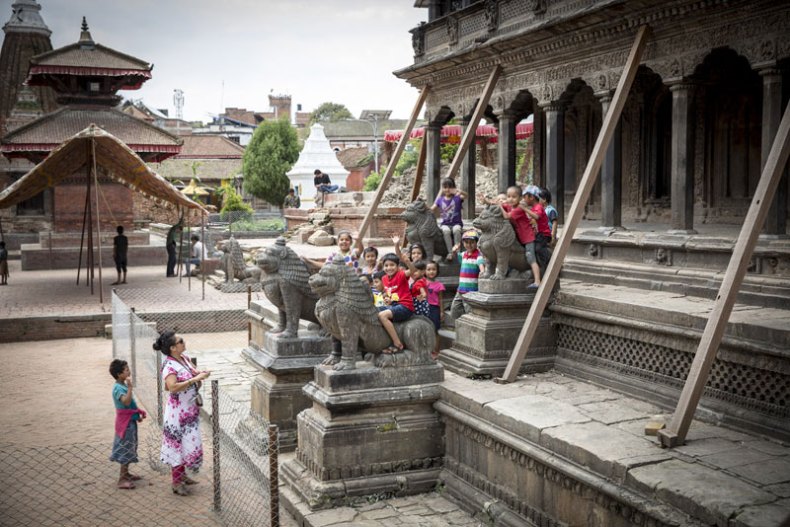
Children play on the stone lions at the base of the Khrishna Mandir, which was shored up after the 2015 earthquake and awaits restoration by the KVPT. Photo: Scott Newman
For the anniversary of the earthquake, senior members of the Nepal government officially inaugurated KVPT’s restoration of the Mani Mandapas along with four other major rebuilding and restoration projects as a symbol of the government’s new reconstruction programme. India, Britain, Japan, the US and many individuals in Nepal and elsewhere have pledged support for KVPT’s projects. Several other initiatives in Kathmandu are in discussion, and KVPT also has plans to collaborate with the governments of Nepal and Austria to restore the Patan Museum (in one of the palace courtyards) and several other monuments in the Darbar Square. In addition to these, the government is spearheading a few smaller restoration projects in Patan Durbar – the Taleju Bell, on an open-air pedestal in the Square; the Nasal Cok, one of the minor palace wings; and the Yoganarendra pillar, a tall stone column facing the palace – with KVPT in an advisory role.
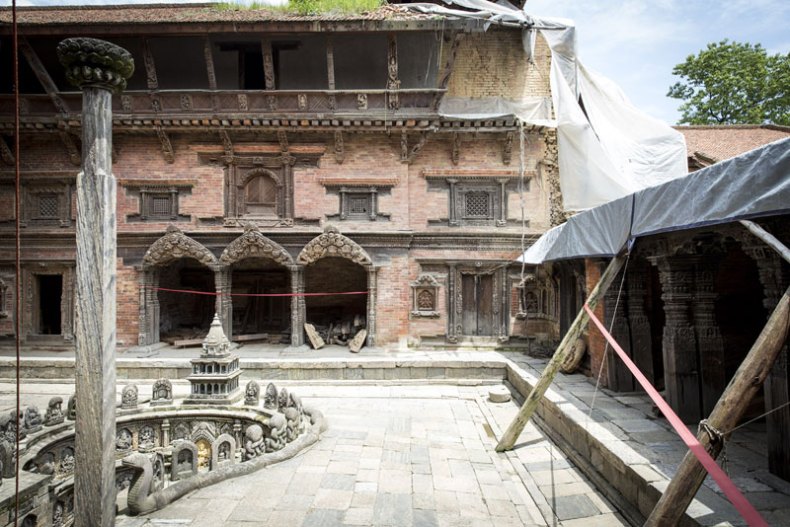
Sundari Cok Courtyard, Patan Palace, with the Tusha Hiti (royal stepwell) left foreground. The East wing of the Sundari Cok, which was awaiting funding for restoration in 2015, suffered significant damage. Sundari Cok is the jewel of the Patan Palace and the central exhibit of the new Patan Museum wings focusing on Nepalese architecture (restored by KVPT, opened in 2014). Photo: Scott Newman
Nepal’s world heritage sites are still fascinating and beautiful, but visitors will see scaffolding there for years to come – and that’s a good thing.
Visit the Kathmandu Valley Preservation Trust website for more information about the ongoing restoration work in the area – and donate to the Trust here.
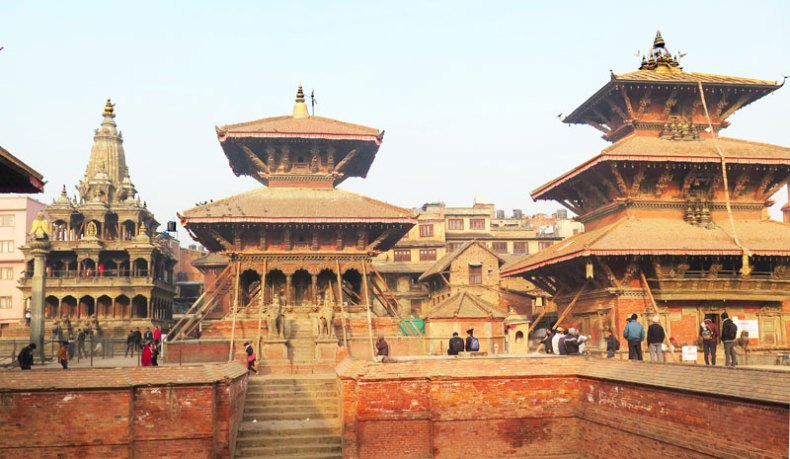
View from Patan Palace north wing toward the royal square, with the Vishveshvara temple (shored) at center; Krishna Mandir (far left), and the 1680 Bhimsen temple (right). In the foreground is the 17th-century stepwell or Manidhara, with the ruins of the two Mani Mandapas just beyond its back wall. Photo: KVPT

One year on: an update from Nepal’s earthquake-damaged heritage sites
Pigeons take off from the top of the 1637 Krishna Mandir in Patan Darbar Square, one of Nepal's finest stone śikhara-style temples. Curtains placed by worshipers are evidence of the temple as 'living heritage', a designation given to the square's many temples, which are in active daily use. Photo: Scott Newman
Share
This week marks the anniversary of the devastating Nepal earthquake of April 2015. A year after magnitude 7.8 tremors wreaked havoc on over 900 heritage buildings and caused over 8,000 deaths in the Kathmandu Valley, conditions are still difficult. The Indian blockade, which cut off many supplies to the Valley, ended only in March; government bureaucracy has been slow and difficult; materials are scarce and often poor in quality. The needs are enormous, and many monuments in this extraordinary pocket of seven UNESCO world heritage sites may never be rebuilt.
Pre-earthquake panoramic view of Patan Darbar (Royal) Square as seen from the Patan Palace. (The palace west facade is visible at the far ends of the photo). Photo: KVPT
Patan Darbar Square with the Krishna Temple (centre), the Vishveshvara Temple (right) and the Carnarayan Temple (left) (c. 1855), Henry Ambrose Oldfield. British Library
There are signs of progress, though. One local organisation was ready to help immediately after the earthquake. The Kathmandu Valley Preservation Trust, an American and Nepalese charity that has worked since 1991 to preserve and restore the Valley’s extraordinary architectural heritage (and for which we work), responded within days to the damages and collapsed monuments. Efforts focused on the country’s finest urban ensemble and its most visited cultural site, the Patan Palace and Royal Square, but also encompassed other sites in Patan and Kathmandu. Before it was safe to return to their own homes, KVPT’s staff organised local efforts to protect all the loose pieces of the fallen and damaged structures in Patan Darbar from looting and monsoon rains, and then collected them in the palace courtyards. A workshop was created in the palace gardens to house the beautiful wood carvings and other artefacts, and to sort, identify, and repair them in preparation for rebuilding.
Elaborately carved wooden struts rescued from a temple that collapsed in Patan Darbar Square, stacked in the courtyard of the Keshav Narayan Cok, a palace wing restored in the 1990s by the Austrian government that now houses the Patan Museum. The struts will be incorporated into the rebuilt temple. Photo: Scott Newman
Architectural fragments rescued from the debris of a fallen temple in Patan Darbar Square are sheltered in a palace courtyard, now part of the Patan Museum, awaiting conservation and reuse. May 2015. Photo: Scott Newman
In the subsequent months, a worldwide outpouring of support, including a royal visit by Prince Harry just last month to see the Patan Palace restoration launched by his father, has helped the Trust to begin planning and design for over a dozen damaged temples, palace towers, rest houses and other structures in the royal palace and square. Because KVPT projects include careful structural designs for earthquake resistance, only three of the Trust’s past projects suffered significant earthquake damage. The Trust continues to improve the seismic strength of threatened structures, making the greatest possible use of traditional techniques in combination with unobtrusive new measures to help increase future safety and durability. KVPT brings a quarter-century of experience to these specialised structures, and is the only organisation to work closely and regularly with the Nepal government on such projects.
Britain’s Prince Harry speaks with officials as he visits heritage sites in Patan Durbar Square on the outskirts of Kathmandu on 20 March, 2016. PRAKASH MATHEMA/AFP/Getty Images
The Trust’s focus on Patan Darbar for a five-year earthquake response campaign will allow it to concentrate efforts on five of Nepal’s most significant structures, all of which were damaged or collapsed in the earthquake. These extraordinary buildings – the Sundari Cok Palace; the 16th-century pagoda-style Char Narayana Temple; Harishankara Temple; Vishveshvara temple (standing but with shoring); and the carved stone Krishna Mandir – are world-class monuments demanding the highest level of restoration. Other projects include rebuilding the Mani Mandapas – two open-air pavilions flanking the entrance to the large stepwell that has traditionally provided water to the neighbourhood.
Children play on the stone lions at the base of the Khrishna Mandir, which was shored up after the 2015 earthquake and awaits restoration by the KVPT. Photo: Scott Newman
For the anniversary of the earthquake, senior members of the Nepal government officially inaugurated KVPT’s restoration of the Mani Mandapas along with four other major rebuilding and restoration projects as a symbol of the government’s new reconstruction programme. India, Britain, Japan, the US and many individuals in Nepal and elsewhere have pledged support for KVPT’s projects. Several other initiatives in Kathmandu are in discussion, and KVPT also has plans to collaborate with the governments of Nepal and Austria to restore the Patan Museum (in one of the palace courtyards) and several other monuments in the Darbar Square. In addition to these, the government is spearheading a few smaller restoration projects in Patan Durbar – the Taleju Bell, on an open-air pedestal in the Square; the Nasal Cok, one of the minor palace wings; and the Yoganarendra pillar, a tall stone column facing the palace – with KVPT in an advisory role.
Sundari Cok Courtyard, Patan Palace, with the Tusha Hiti (royal stepwell) left foreground. The East wing of the Sundari Cok, which was awaiting funding for restoration in 2015, suffered significant damage. Sundari Cok is the jewel of the Patan Palace and the central exhibit of the new Patan Museum wings focusing on Nepalese architecture (restored by KVPT, opened in 2014). Photo: Scott Newman
Nepal’s world heritage sites are still fascinating and beautiful, but visitors will see scaffolding there for years to come – and that’s a good thing.
Visit the Kathmandu Valley Preservation Trust website for more information about the ongoing restoration work in the area – and donate to the Trust here.
View from Patan Palace north wing toward the royal square, with the Vishveshvara temple (shored) at center; Krishna Mandir (far left), and the 1680 Bhimsen temple (right). In the foreground is the 17th-century stepwell or Manidhara, with the ruins of the two Mani Mandapas just beyond its back wall. Photo: KVPT
Unlimited access from just $16 every 3 months
Subscribe to get unlimited and exclusive access to the top art stories, interviews and exhibition reviews.
Share
Recommended for you
Reconstruction work to begin on Nepal’s damaged heritage sites
Art News Daily : 25 April
Rubin Museum to honour anniversary of Nepal earthquakes
Art News Daily : 20 April
How extensive is the cultural damage in Nepal?
Unesco World Heritage sites are severely damaged, but reconstruction might be an option